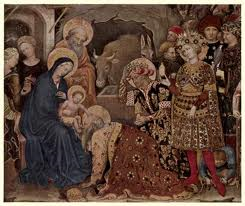Twelfth Night is a festival marking the coming of the Epiphany and concluding the Twelve Days of Christmas.
In medieval and Tudor England, the Twelfth Night marked the end of a winter festival that started on All Hallows Eve — now more commonly known as Hallowe’en. The Lord of Misrule symbolizes the world turning upside down. On this day the King and all those who were high would become the peasants and vice versa. At the beginning of the Twelfth Night festival, a cake that contained a bean was eaten. The person who found the bean would rule the feast. Midnight signaled the end of his rule and the world would return to normal. The common theme was that the normal order of things was reversed. This Lord of Misrule tradition dates back to pre-Christian European festivals such the Ancient Roman festival of Saturnalia.
(Shakespeare’s play Twelfth Night, or What You Will was written to be performed as a Twelfth Night entertainment. The play has many elements of the Lord of Misrule theme, in the tradition of Twelfth Night, such as a woman Viola dressing as a man, and a servant Malvolio imagining that he can become a nobleman.)
Food and drink are the center of the celebrations in modern times, and all of the most traditional ones go back many centuries. The punch called wassail is consumed especially on Twelfth Night, but throughout Christmas time, especially in the UK. Around the world, special pastries, such as the tortell and king cake are baked on Twelfth Night, and eaten the following day for the Feast of the Epiphany celebrations. In English and French custom, the Twelfth-cake was baked to contain a bean and a pea, so that those who received the slices containing them should be designated king and queen of the night’s festivities.
In colonial America, a Christmas wreath was always left up on the front door of each home, and when taken down at the end of the Twelve Days of Christmas, any edible portions would be consumed with the other foods of the feast. The same held true in the 19th-20th centuries with fruits adorning Christmas trees. Fresh fruits were hard to come by, and were therefore considered fine and proper gifts and decorations for the tree, wreaths, and home. Again, the tree would be taken down on Twelfth Night, and such fruits, along with nuts and other local produce used, would then be consumed.
In the eastern Alps, a tradition called Perchtenlaufen exists. Two to three hundred masked young men rush about the streets with whips and bells driving out evil spirits. In Nuremberg until 1616, children frightened spirits away by running through the streets and knocking loudly at doors. In some countries the Twelfth Night and Epiphany marks the start of the Carnival season, which lasts through Mardi Gras Day. Modern American Carnival traditions shine most brightly in New Orleans, where friends gather for weekly King Cake parties. Whoever gets the slice with the “king”, usually in the form of a miniature baby doll (symbolic of the Christ Child, “Christ the King”), hosts next week’s party.
(The Shorter Oxford English Dictionary reads “the evening of the fifth of January, preceding Twelfth Day, the eve of the Epiphany, formerly the last day of the Christmas festivities and observed as a time of merrymaking”. There is some confusion these days, however, as to which night is Twelfth Night: modern practice is often to regard the night of Epiphany itself (sixth of January) to be Twelfth Night. The older tradition of Twelfth Night being the 5 January stems from the medieval practice of the day beginning at sunset, rather than at midnight as it does now. Thus Twelfth Night falls on 5 January, ahead of Twelfth Day on the 6th.)

